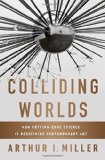June 20, 2014

Quantum Models of Cognition and Decision by Jerome R. Busemeyer and Peter D. Bruza (Cambridge University Press, 2014)
(kindle ed.), (amazon.co.uk), (UK kindle ed.)
Book description from the publisher:
Much of our understanding of human thinking is based on probabilistic models. This innovative book by Jerome R. Busemeyer and Peter D. Bruza argues that, actually, the underlying mathematical structures from quantum theory provide a much better account of human thinking than traditional models. They introduce the foundations for modelling probabilistic-dynamic systems using two aspects of quantum theory. The first, ‘contextuality’, is a way to understand interference effects found with inferences and decisions under conditions of uncertainty. The second, ‘quantum entanglement’, allows cognitive phenomena to be modeled in non-reductionist ways. Employing these principles drawn from quantum theory allows us to view human cognition and decision in a totally new light. Introducing the basic principles in an easy-to-follow way, this book does not assume a physics background or a quantum brain and comes complete with a tutorial and fully worked-out applications in important areas of cognition and decision.
Google Books preview:
Comments (0)
- cognitive science,new books
June 18, 2014
Some highlights:
Browse the Nonfiction list.
Comments (0)
- Uncategorized
June 15, 2014

Colliding Worlds: How Cutting-Edge Science Is Redefining Contemporary Art by Arthur I. Miller (W.W. Norton, 2014)
(kindle ed.), (amazon.co.uk), (UK kindle ed.)
Book description from the publisher:
A dazzling look at the artists working on the frontiers of science.
In recent decades, an exciting new art movement has emerged in which artists utilize and illuminate the latest advances in science. Some of their provocative creations—a live rabbit implanted with the fluorescent gene of a jellyfish, a gigantic glass-and-chrome sculpture of the Big Bang (pictured on the cover)—can be seen in traditional art museums and magazines, while others are being made by leading designers at Pixar, Google’s Creative Lab, and the MIT Media Lab. In Colliding Worlds, Arthur I. Miller takes readers on a wild journey to explore this new frontier.
Miller, the author of Einstein, Picasso and other celebrated books on science and creativity, traces the movement from its seeds a century ago—when Einstein’s theory of relativity helped shape the thinking of the Cubists—to its flowering today. Through interviews with innovative thinkers and artists across disciplines, Miller shows with verve and clarity how discoveries in biotechnology, cosmology, quantum physics, and beyond are animating the work of designers like Neri Oxman, musicians like David Toop, and the artists-in-residence at CERN’s Large Hadron Collider.
From NanoArt to Big Data, Miller reveals the extraordinary possibilities when art and science collide.
Google Books preview:
See also: Author’s website
Comments (0)
- culture,new books




